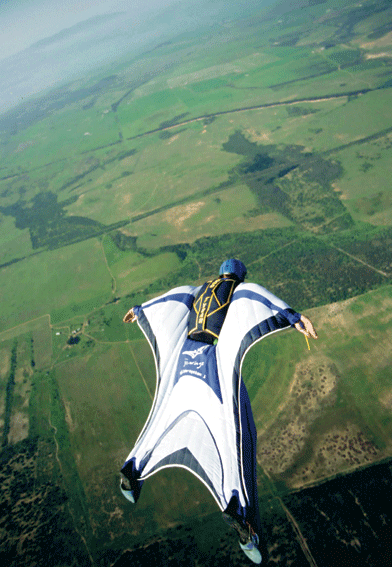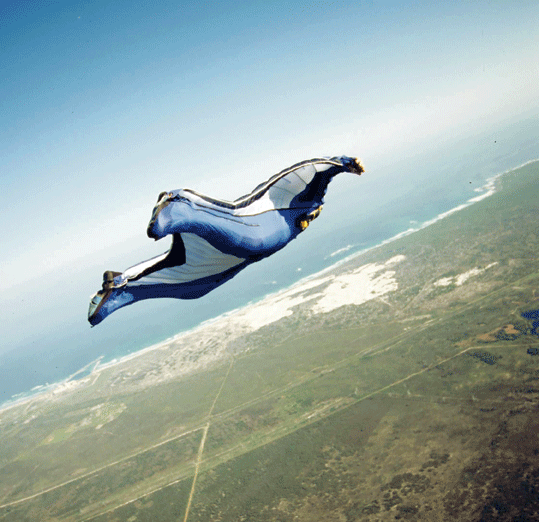
![]() Travel and Adventure
Travel and Adventure
South Africa
Will the ‘Flying Squirrel’ Suit Let Skydivers Jump without Chutes?
It sounds crazy, and it probably is: Skydive from 15,000 feet (4,600 meters) and land safely – without a parachute – wearing a getup that resembles a flying squirrel costume.
By: Sean Markey *
“It’s pretty much considered impossible,” says Maria von Egidy, a designer with Jii Wings in Cape Town, South Africa.
Von Egidy isn’t interested in trying the stunt herself. But she aims to design the first wingsuit that will help pull it off.
Wingsuits are jumpsuits with fabric panels between the arms and legs that enable skydivers to zoom around in freefall. By angling the self-inflating, rigid “wings,” pilots can turn, dive or rocket forward.
What wearers can’t do – at least not yet – is land safely with out the aid of a parachute.
“In terms of downward speed, we’re actually within the margin of safety there for landing,” von Egidy says. “But of course the forward speeds are tremendous.” And therein lies the catch.
If pushed from a high-flying plane, a naked human would fall to Earth at a terminal velocity – or maximum speed – of about 120 miles (190 kilometers) an hour.
A wingsuit doubles a person’s surface area, slowing the descent rate to about 30 miles (50 kilometers) an hour, about the same as with a small parachute, von Egidy says.
The main problem with making a safe landing is that wingsuit pilots descend not only downward but also forward, propelled by the gliding action of their wings.
Forward speeds can top 75 to 90 miles (120 to 150 kilometers) an hour.
 For now, wingsuit pilots deploy a parachute at the end of their jumps to slow their descent for touchdown.
For now, wingsuit pilots deploy a parachute at the end of their jumps to slow their descent for touchdown.
But a few pilots and designers have been exploring ways to set down on solid ground without the aid of a chute.
Some, like BASE (building, antennae, spans, and Earth) jumper Jeb Corliss of Malibu, Calif., are reportedly experimenting with landing gear or special surfaces. Von Egidy has a different idea.“We’re trying to flare the suit without using landing gear (but) with aerodynamics,” she says. “It’s really a very simple solution in the end.”
The designer won’t discuss her plans in more detail, lest she divulge trade secrets. But she does say that the key to her concept is to create a forward brake at the right moment. “Our design efforts are centered around solving that problem,” she says.
Von Egidy’s passion for the wingsuit might seem ironic, as she has never skydived at all, let alone jumped wearing one of her prototypes.
Instead she relies on a clutch of experienced skydivers around the world to test the suits and report on their performance.
“I don’t have the luxury of actually experiencing it myself,” von Egidy says. “So I have to rely on really good descriptions from (the testers).”
Jean Potvin, a physics professor at St. Louis University in Missouri, analyzes parachute safety for the Parks College Parachute Research Group.
Potvin, a veteran skydiver who’s logged more than 2,400 jumps, believes it’s possible to land the right wingsuit without a parachute.
But, he says, the very high speeds involved and the potential for pilot error pose huge risks.
“It’s something that’s doable, but it’s ... fraught with danger,” Potvin says.
Whether von Egidy’s strategy will work remains to be seen. She says it will be another few months before a prototype can be safely tested in the air.
In the meantime, she and business partner Cate Turner will continue to subsidize their wingsuit work with income from their main business: Tailors of Tinseltown, which supplies costumes to South Africa’s television and film industry.
As for her quest to design the first wingsuit to safely deliver a person to Earth, the South African says she harbors few doubts she will succeed.
“The preliminary ground tests are very positive,” she says. “Everybody who knows what I’m doing believes in it. It’s just a good idea that no one spotted.”
* Sean Markey is a regular contributor to National Geographic News.